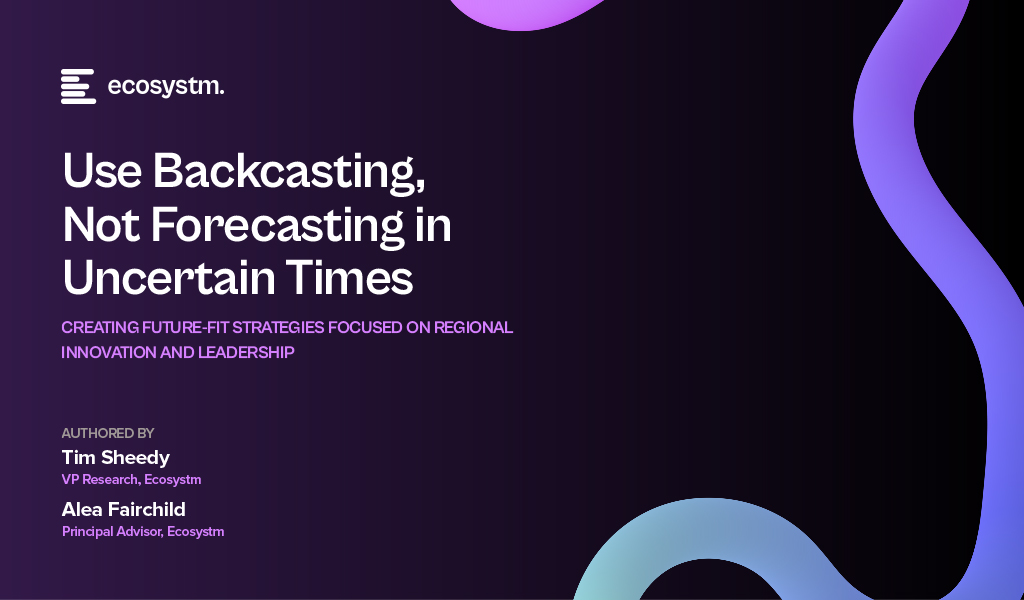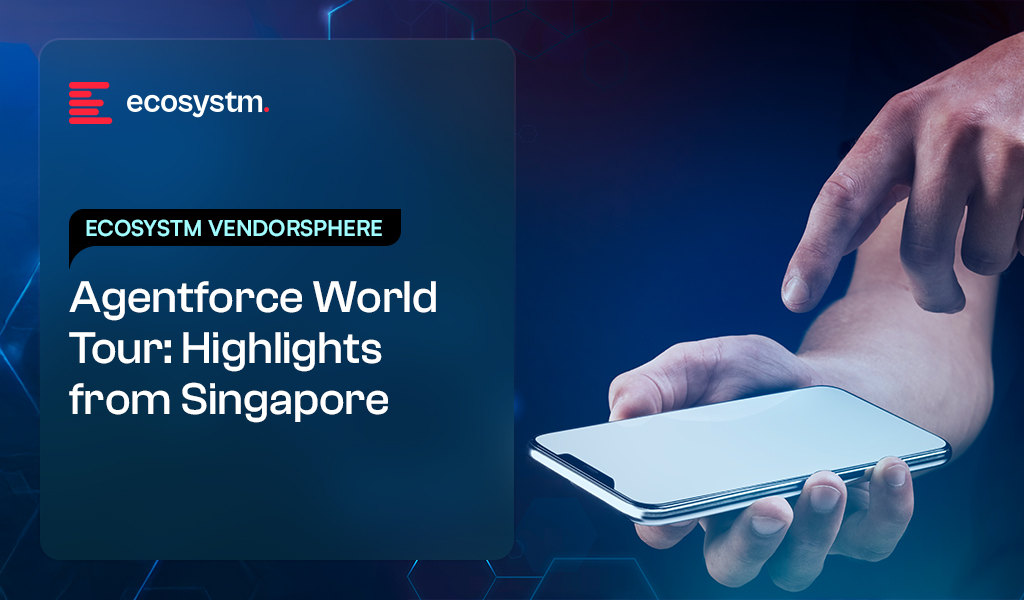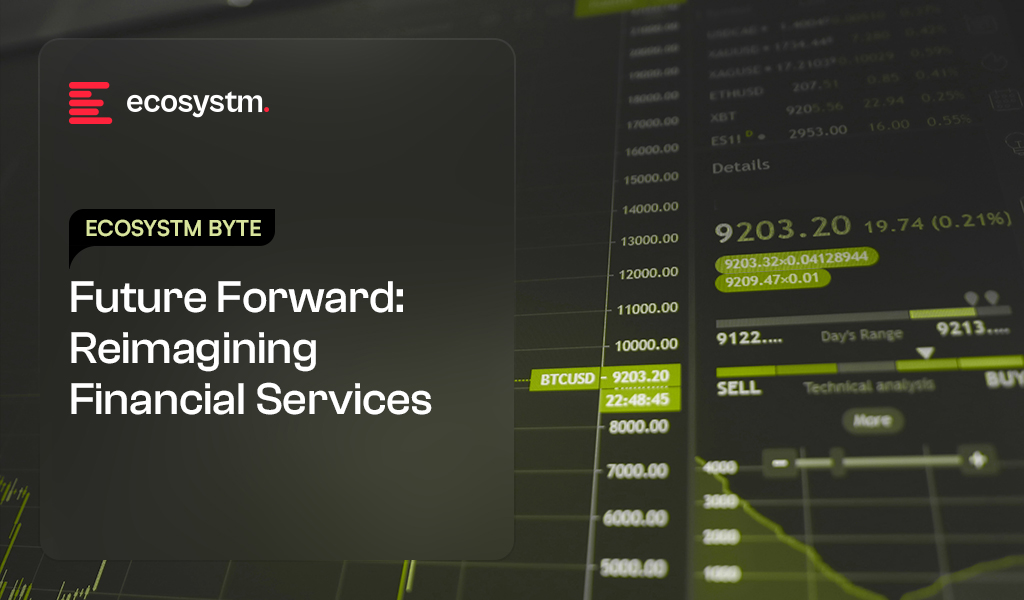As one of Asia’s most digitally mature economies, Singapore was an early mover in national digital transformation and is now turning that head start into resilient, innovation-led economic value. Today, the conversation across boardrooms, regulators, and industry circles has evolved: it’s no longer just about adopting technology but about embedding digital as a systemic driver of competitiveness, inclusion, and sustained growth.
Singapore’s approach offers a model for the region, with its commitment to building a holistic digital ecosystem. This goes beyond infrastructure, it includes nurturing digital talent, fostering a vibrant innovation and startup culture, enabling trusted cross-border data flows, and championing public-private collaboration. Crucially, its forward-looking regulatory stance balances support for experimentation with the need to uphold public trust.
Through our conversations with leaders in Singapore and Ecosystm’s broader research, we see a country intentionally architecting its digital future, focused on real-world outcomes, regional relevance, and long-term economic resilience.
Here are five insights that capture the pulse of Singapore’s digital transformation.
Theme 1: Digital Governance as Strategy: Setting the Pace for Innovation & Trust
Singapore’s approach to digital governance goes beyond policy. It’s a deliberate strategy to build trust, accelerate innovation, and maintain economic competitiveness. The guiding principle is clear: technology must be both transformative and trustworthy.
This vision is clearly visible in the public sector, where digital platforms and services are setting the pace for the rest of the economy. Public service apps are designed to be citizen-centric, secure, and efficient, demonstrating how digital delivery can work at scale. The Government Tech Stack allows agencies to rapidly build and integrate services using shared APIs, cloud infrastructure, and secure data layers. Open data initiatives like Data.gov.sg unlock thousands of datasets, while tools such as FormSG and SG Notify make it easy for any organisation to digitise services and engage users in real time.
By leading with well-designed digital infrastructure and standards, the public sector creates blueprints that others can adopt, lowering the barriers to innovation for businesses of all sizes. For SMEs in particular, these tools and frameworks offer a practical foundation to modernise operations and participate more fully in the digital economy.
Singapore is also setting clear rules for responsible tech. IMDA’s Trusted Data Sharing Framework and AI Verify establish standards for secure data use and transparent AI, giving businesses the certainty they need to innovate with confidence. All of this is underpinned by strategic investments in digital infrastructure, including a new generation of sustainable, high-capacity data centres to meet growing regional demand. In Singapore, digital governance isn’t a constraint, it’s a catalyst.

Theme 2: AI in Singapore: From Experimentation to Accountability
Few places have embraced AI’s potential as strongly as Singapore. In 2022 and 2023, fuelled by the National AI Strategy and commercial pressure to deliver results, organisations across industries rushed into pilots in 2022 and 2023. Ecosystm research shows that by 2024, nearly 82% of large enterprises in Singapore were experimenting with AI, with 37% deploying it across multiple departments.
However, that initial wave of excitement soon gave way to realism. Leaders now speak candidly about AI fatigue and the growing demand for measurable returns. The conversation has shifted from “What can we automate?” to “What’s actually worth scaling?” Organisations are scrutinising whether their AI projects deliver tangible value, integrate into daily operations, and meet evolving regulatory expectations.
This maturity is especially visible in Singapore’s banking sector, where the stakes are high and scrutiny is intense. Banks were among the first to embrace AI aggressively and are now leading the shift toward disciplined prioritisation. From actively hunting down use cases, they’ve pivoted to focusing on the select few that deliver real business outcomes. With increasing pressure to ensure transparency, auditability, and alignment with global standards, finance leaders are setting the tone for AI accountability across the economy.
The result: a more grounded, impact-focused AI strategy. While many regional peers are still chasing pilots, Singapore is entering a new phase, defined by fewer but better AI initiatives, built to solve real problems and deliver meaningful ROI.

Theme 3: The Cyber Imperative: Trust, Recovery, and Resilience
Singapore’s digital leadership brings not only opportunities but also increased exposure to cyber threats. In 2024 alone, the country faced 21 million cyberattacks, ranking eighth globally as both a target and a source. High-profile breaches, from vendor compromises affecting thousands of banking customers to earlier incidents like the SingHealth data breach, have exposed vulnerabilities across critical sectors.
These incidents have sparked a fundamental shift in Singapore’s cybersecurity mindset from building impenetrable digital fortresses to embracing digital resilience. The government recognises that breaches are inevitable and prioritises rapid containment and recovery over prevention alone. Regulatory bodies like MAS have tightened incident reporting rules, demanding quicker, more transparent responses from affected organisations.
For enterprises in Singapore, cybersecurity has moved beyond a technical challenge to become a strategic imperative deeply tied to customer trust and business continuity. Leaders are investing heavily in real-time threat detection, incident response, and crisis management capabilities. In a landscape where vulnerabilities are real and constant, cyber resilience is now a critical competitive advantage because in Singapore’s digital economy, trust and operational reliability are non-negotiable.

Theme 4: Beyond Coding: Singapore’s Quest for Hybrid Digital Talent
Singapore’s digital ambitions increasingly depend on its human capital. While consistently ranking high in global talent competitiveness, the city-state faces a projected shortfall of over 1.2 million digitally skilled workers, particularly in fields like cybersecurity, data science, and AI engineering.
But the challenge isn’t purely technical. Organisations now demand talent that bridges technology, business strategy, and regulatory insight. Many digital initiatives stall not from technology limitations, but from a lack of professionals who can translate complex digital concepts into business value and ensure regulatory compliance.
To address this, government initiatives like the TechSkills Accelerator (TeSA) offer training subsidies and career conversion programmes. Meanwhile, leading tech providers including AWS, Microsoft, Google, and IBM, are stepping up, partnering with government and industry to deliver specialised training, certification programmes, and talent pipelines that help close the skills gap.
Still, enterprises grapple with keeping pace amid rapid technological change, balancing reskilling local talent with attracting specialised professionals from abroad. The future of Singapore’s digital economy will be defined as much by people as by technology; and by the partnerships that help bridge this critical gap.

Theme 5: Tracking Impact, Driving Change: Singapore’s Sustainability and Tech Synergy
Sustainability remains a core pillar of Singapore’s digital ambitions, driven by the government’s unwavering focus and supportive green financing options unlike in some markets where momentum has slowed. Anchored by the Singapore Green Plan 2030, the nation aims to double solar energy capacity and reduce landfill waste per capita by 30% by 2030.
Digital technology plays a critical role in this vision. Initiatives like the Green Data Centre Roadmap promote energy-efficient infrastructure and sustainable cooling technologies, balancing growth in the digital economy with carbon footprint management. Singapore is also emerging as a regional hub for carbon services, leveraging digital platforms such as the Carbon Services Platform to track, verify, and trade emissions, fostering credible and transparent carbon markets.
Government-backed green financing schemes, including the Green Bond Grant Scheme and Sustainability-Linked Loans, are accelerating investments in eco-friendly projects, enabling enterprises to fund sustainable innovation while meeting global ESG standards.
Despite these advances, leaders highlight challenges such as the lack of standardised sustainability metrics and rising risks of greenwashing, which complicate scaling green finance and cross-border sustainability reporting. Still, Singapore’s ability to integrate sustainability with digital innovation underscores its ambition to be more than a tech hub. It aims to be a trusted leader in building a responsible, future-ready economy.

From Innovation to Lasting Impact
Singapore stands at a critical inflection point. Already recognised as one of the world’s most advanced digital economies, its greatest test now is execution transforming cutting-edge technology from promise into real, everyday impact. The nation must balance rapid innovation with robust security, while shaping global standards that reflect its unique blend of ambition and pragmatism.
With deep-rooted trust across government, industry, and society, Singapore is uniquely equipped to lead not just in developing technology, but in embedding it responsibly to create lasting value for its people and the wider region. The next chapter will define whether Singapore can move from digital leadership to digital legacy.

Thailand’s digital transformation has shifted from an ambitious policy agenda to a national necessity. As the country accelerates its Thailand 4.0 strategy, digital platforms are becoming central to boosting competitiveness, enhancing public services, and building economic resilience. From logistics and healthcare to finance and manufacturing, digital tools now underpin how Thailand moves, heals, pays, and grows.
Recent reforms, including the National AI Strategy, Smart City Masterplan, and National Digital ID framework, have been paired with efforts to strengthen digital infrastructure nationwide. Yet challenges remain: integrating platforms across government, closing the generational digital divide, and safeguarding vulnerable users in a rapidly evolving fintech and gig economy.
Through multiple roundtables and stakeholder dialogues, Ecosystm has uncovered five core themes that highlight both the momentum and the friction points in Thailand’s digital journey.
Theme 1: Bridging the Regional Divide
Thailand’s digital transformation is accelerating in urban centres like Bangkok, Chonburi, and Rayong, but rural and low-income regions, especially in the North and Deep South, continue to lag. Gaps in connectivity, digital skills, and modern technical education are limiting access to online learning, mobile banking, and digital public services, while also holding back the growth of tech-driven industries.
Initiatives like Net Pracharat have brought broadband to over 75,000 villages, and new investments in regional data centres and telecom infrastructure show promise. Still, last-mile gaps and fragile networks persist, particularly in conflict-affected or underserved areas. Even where fibre is available, unstable connections often block meaningful digital adoption.
At the same time, Thailand’s push into future-focused industries such as EVs, semiconductors, AI, and smart logistics, is straining its talent pipeline. The Eastern Economic Corridor (EEC) is attracting major investment, but the demand for skilled workers in data science, cybersecurity, and industrial AI far exceeds supply. Many regional technical education systems have not kept pace, widening the skills gap.
To ensure inclusive growth, Thailand needs to pair infrastructure investment with targeted reskilling and education reform. Programs like the Digital Skill Development Academy and revamped TVET initiatives are important first steps; but broader progress will require stronger industry-academia partnerships, faster certification pathways, and universal access to digital learning.
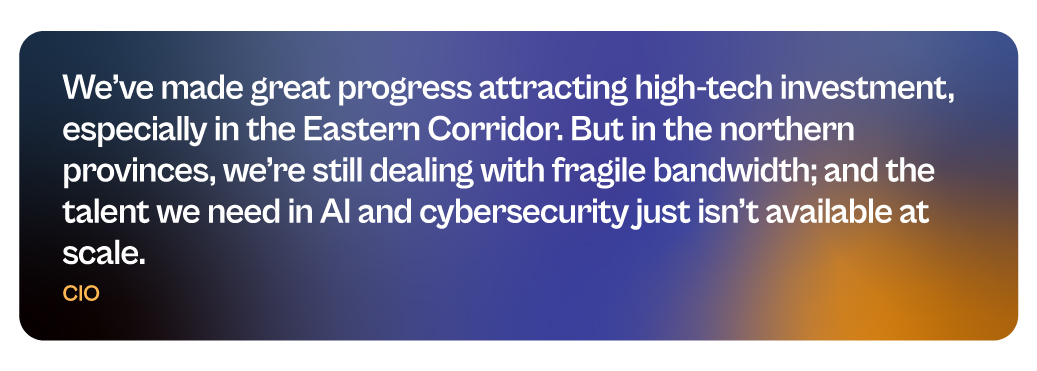
Theme 2: Unifying Government Services for a Seamless Citizen Journey
From PromptPay-linked welfare payments and Mor Prom for health services, to the rollout of the NDID (National Digital ID), Thailand has made considerable progress in digitalising public services. Citizens can now access more services online than ever before.
However, many of these systems still operate in silos, with duplicated citizen data, separate logins, and limited backend integration between agencies. Ministries and local governments often lack the interoperability standards and cloud infrastructure needed to provide seamless, real-time services.
The next phase of government digitalisation must focus on platform-level integration, supported by secure data sharing frameworks, API-first design, and privacy-by-default policies. The goal is to move from digitising transactions to building a citizen-centric, connected state, where services are proactive, mobile-friendly, and unified across domains.

Theme 3: Strengthening Public Trust Through Proactive Cybersecurity
With the rise of digital government, cloud adoption, and cashless ecosystems, Thailand’s attack surface is rapidly expanding. High-profile breaches in healthcare, telecom, and finance have triggered growing public concern around data misuse, fraud, and infrastructure vulnerabilities.
The government has enacted the Cybersecurity Act (2019) and PDPA (2022), and agencies like the National Cybersecurity Agency (NCSA) are stepping up threat monitoring. But cybersecurity maturity across sectors remains uneven. Many SMEs, regional hospitals, and even provincial government systems operate with limited threat intelligence and minimal incident response protocols.
Cybersecurity must now move from compliance to strategic resilience. This includes building sector-specific response plans, launching cyber drills in critical infrastructure, and scaling cyber talent development across the country. Trust in digital services will depend not just on what’s offered, but on how securely it’s delivered.

Theme 4: Scaling Trust Through Local Language, Visibility, and Human Oversight
AI systems in Thailand are increasingly interfacing with the public, from chatbots and digital assistants to automated approvals and diagnostics. However, public trust in these systems remains fragile, particularly when users cannot understand how decisions are made or get help when things go wrong.. Language barriers and unclear design only add to the uncertainty.
Many AI tools are built in English-first environments, with limited Thai-language optimisation or cultural context. In rural areas or among older populations, this can create friction and resistance, even when the underlying system works well. Without transparency, user control, or recourse, AI tools risk being seen as alienating rather than empowering.
To build public confidence, AI deployments must prioritise explainability, Thai-language usability, and built-in pathways for human support. This includes interface localisation, clear model intent statements, and fallback mechanisms. Trust will not be built through performance alone, it must be earned through transparency, accessibility, and responsiveness.

Theme 5: Embedding Governance to Sustain Smart Urban Growth
Thailand has made significant headway in its smart city development agenda, with over 30 provinces participating in the national Smart City program. Flagship initiatives in Phuket, Chiang Mai, Khon Kaen, and parts of the EEC have introduced smart traffic systems, e-governance tools, environmental monitoring, and digital tourism platforms.
However, many smart city projects are still pilots, driven by local champions, reliant on short-term grants, and lacking long-term governance structures. Fragmented data, unclear stakeholder roles, and limited collaboration between cities continue to slow scale and national replication.
The Smart City Office under DEPA is working to address these challenges by developing standard frameworks, urban data platforms, and public-private investment models. To maintain momentum, Thailand will need to embed smart city governance in multi-year digital urban strategies, establish shared infrastructure foundations, and invest in capacity-building for local leaders.
For smart cities to succeed, they must move beyond tech demonstrations and deliver real, lasting improvements in liveability, safety, and economic opportunity.

Sustaining Momentum in a Connected Nation
Thailand’s digital future won’t be defined by policy or technology alone; but by how effectively the country aligns infrastructure, skills, services, and trust at scale. The foundations are already being built in classrooms, city halls, data centres, and boardrooms. The real opportunity lies in weaving these efforts into a cohesive, resilient digital fabric. Lasting impact will come not just from momentum, but from turning vision into everyday value for people, communities, and businesses alike.

Consider the sheer volume of information flowing through today’s financial systems: every QR payment, e-KYC onboarding, credit card swipe, and cross-border transfer captures a data point. With digital banking and Open Banking, financial institutions are sitting on a goldmine of insights. But this isn’t just about data collection; it’s about converting that data into strategic advantage in a fast-moving, customer-driven landscape.
With digital banks gaining traction and regulators around the world pushing bold reforms, the industry is entering a new phase of financial innovation powered by data and accelerated by AI.
Ecosystm gathered insights and identified key challenges from senior banking leaders during a series of roundtables we moderated across Asia Pacific. The conversations revealed a clear picture of where momentum is building – and where obstacles continue to slow progress. From these discussions, several key themes emerged that highlight both opportunities and ongoing barriers in the Banking sector.
1. AI is Leading to End-to-End Transformation
Banks are moving beyond generic digital offerings to deliver hyper-personalised, data-driven experiences that build loyalty and drive engagement. AI is driving this shift by helping institutions anticipate customer needs through real-time analysis of behavioural, transactional, and demographic data. From pre-approved credit offers and contextual investment nudges to app interfaces that adapt to individual financial habits, personalisation is becoming a core strategy, not just a feature. This is a huge departure from reactive service models, positioning data as a long-term strategic asset.
But the impact of AI isn’t limited to customer-facing experiences. It’s also driving innovation deep within the banking stack, from fraud detection and SME loan processing to intelligent chatbots that scale customer support. On the infrastructure side, banks are investing in agile, AI-ready platforms to support automation, model training, and advanced analytics at scale. These shifts are redefining how banks operate, make decisions, and deliver value. Institutions that integrate AI across both front-end journeys and back-end processes are setting a new benchmark for agility, efficiency, and competitiveness in a fast-changing financial landscape.

2. Regulatory Shifts are Redrawing the Competitive Landscape
Regulators are moving quickly in Asia Pacific by introducing frameworks for Open Banking, real-time payments, and even AI-specific standards like Singapore’s AI Verify. But the challenge for banks isn’t just keeping up with evolving external mandates. Internally, many are navigating a complicated mix of overlapping policies, built up over years of compliance with local, regional, and global rules. This often slows down innovation and makes it harder to implement AI and automation consistently across the organisation.
As banks double down on AI, it is clear that governance can’t be an afterthought. Many are still dealing with fragmented ownership of AI systems, inconsistent oversight, and unclear rules around things like model fairness and explainability. The more progressive ones are starting to fix this by setting up centralised governance frameworks, investing in risk-based controls, and putting processes in place to monitor things like bias and model drift from day one. They are not just trying to stay compliant; they are preparing for what’s coming next. In this landscape, the ability to manage regulatory complexity with speed and clarity, both internally and externally, is quickly becoming a competitive edge.

3. Success Depends on Strategy, Not Just Tech
While enthusiasm for AI is high, sustainable success hinges on a clear, aligned strategy that connects technology to business outcomes. Many banks struggle with fragmented initiatives because they lack a unified roadmap that prioritises high-impact use cases. Without clear goals, AI projects often fail to deliver meaningful value, becoming isolated pilots with limited scalability.
To avoid this, banks need to develop robust return-on-investment (ROI) models tailored to their context — measuring benefits like faster credit decisioning, reduced fraud losses, or increased cross-selling effectiveness. These models must consider not only the upfront costs of infrastructure and talent, but also ongoing expenses such as model retraining, governance, and integration with existing systems.
Ethical AI governance is another essential pillar. With growing regulatory scrutiny and public concern about opaque “black box” models, banks must embed transparency, fairness, and accountability into their AI frameworks from the outset. This goes beyond compliance; strong governance builds trust and is key to responsible, long-term use of AI in sensitive, high-stakes financial environments.

4. Legacy Challenges Still Hold Banks Back
Despite strong momentum, many banks face foundational barriers that hinder effective AI deployment. Chief among these is data fragmentation. Core customer, transaction, compliance, and risk data are often scattered across legacy systems and third-party platforms, making it difficult to access the integrated, high-quality data that AI models require.
This limits the development of comprehensive solutions and makes AI implementations slower, costlier, and less effective. Instead of waiting for full system replacements, banks need to invest in integration layers and modern data platforms that unify data sources and make them AI-ready. These platforms can connect siloed systems – such as CRM, payments, and core banking – to deliver a consolidated view, which is crucial for accurate credit scoring, personalised offers, and effective risk management.
Banks must also address talent gaps. The shortage of in-house AI expertise means many institutions rely on external consultants, which increases costs and reduces knowledge transfer. Without building internal capabilities and adjusting existing processes to accommodate AI, even sophisticated models may end up underused or misapplied.

5. Collaboration and Capability Building are Key Enablers
AI transformation isn’t just a technology project – it’s an organisation-wide shift that requires new capabilities, ways of working, and strategic partnerships. Success depends on more than just hiring data scientists. Relationship managers, credit officers, compliance teams, and frontline staff all need to be trained to understand and act on AI-driven insights. Processes such as loan approvals, fraud escalations, and customer engagement must be redesigned to integrate AI outputs seamlessly.
To drive continuous innovation, banks should establish internal Centres of Excellence for AI. These hubs can lead experimentation with high-value use cases like predictive credit scoring or real-time fraud detection, while ensuring that learnings are shared across business units. They also help avoid duplication and promote strategic alignment.
Partnerships with fintechs, technology providers, and academic institutions play a vital role as well. These collaborations offer access to cutting-edge tools, niche expertise, and locally relevant AI models that reflect the regulatory, cultural, and linguistic contexts banks operate in. In a fast-moving and increasingly competitive space, this combination of internal capability building and external collaboration gives banks the agility and foresight to lead.


Digital transformation in the Philippines has moved from being a goal to an essential part of how organisations operate, compete, and serve their communities. This shift is evident across sectors – from financial services and government to education, healthcare, and commerce – as digital platforms become integral to everyday life.
In recent years, the country has been recognised as a leading improver in the UN E-Government Development Index, reflecting steady advances in digital public service delivery. Yet, progress across all sectots has been uneven, influenced by a mix of geography, regulation, and existing infrastructure. Organisations continue to adapt, responding to fast-paced technological change, rising user expectations, and an increasingly interconnected global digital economy.
Through a series of roundtables with national leaders, Ecosystm examined the realities of digital transformation on the ground. What emerged were valuable insights into what’s working and where challenges and shifts are reshaping the definition of success in this evolving stage of digital maturity.
Theme 1: Strengthening the Foundations for Nationwide Digital Equity
The Philippines is advancing steadily in digitalisation, especially in Metro Manila and major urban centres, though the full benefits have yet to reach all regions evenly. Rural provinces and smaller islands face ongoing challenges with broadband access, latency, and mobile coverage, reflecting the country’s unique geography and historic underinvestment in digital infrastructure.
National programs like the National Broadband Plan and Free Wi-Fi for All have established important foundations. Fibre rollouts by private telecom providers are extending coverage, but last-mile connectivity in geographically isolated and disadvantaged areas (GIDAs) still needs attention. Bridging this gap is key not only for broader inclusion but also to enable widespread adoption of technologies such as cloud computing, AI, and edge solutions.
Achieving nationwide digital transformation requires a focused effort on regional infrastructure as a driver of inclusive growth. This involves co-investment, innovative public-private partnerships, and policies supporting shared towers, data centres, and satellite-backed connectivity. This benefits enterprises and critical citizen services like e-learning, e-health, and digital banking.

Theme 2: From Outsourcing Hub to Innovation Engine – The Next Chapter for Talent
The Philippines has established a strong global presence as a trusted centre for BPO and IT-enabled services, contributing nearly 9% to the national GDP and employing over 1.5 million professionals. In recent years, this foundation has rapidly evolved, with talent increasingly taking on complex roles in knowledge process outsourcing (KPO), AI annotation, fintech support, and cybersecurity operations.
This shift reflects a broader transformation – from a labour-cost-driven outsourcing model to a high-skill, innovation-focused services economy. However, this transition is placing growing demands on the talent pipeline. Skilled cloud engineers, AI developers, and cybersecurity experts remain in short supply, with demand surpassing the current capacity of training and reskilling programs.
To fully unlock its potential, the country needs to future-proof its talent ecosystem. This includes expanding technical education, strengthening collaboration between academia and industry, scaling national upskilling initiatives, and creating incentives that encourage tech professionals to build their careers locally. With targeted investment, the digital workforce can become a powerful competitive advantage on the global stage.

Theme 3: Government Digitalisation Is Accelerating – But Interoperability Remains a Challenge
The Philippines has made major progress in digitising government services – from online business registrations via Business Name Registration System (BNRS) to digital ID rollout through PhilSys (Philippine Identification System), and integrated platforms like eGov PH Super App. The pandemic accelerated adoption of e-payment systems, telemedicine, and virtual public services, driving faster digital transformation across agencies.
Despite this progress, interoperability challenges remain a key hurdle. Many government agencies still rely on siloed legacy systems that limit seamless data exchange. This fragmentation affects real-time decision-making, slows service delivery, and creates a fragmented experience for citizens and enterprises navigating multiple platforms.
Going forward, the priority is system-wide integration. Building a truly citizen-centric digital government requires interoperable data architectures, strong privacy-by-design frameworks for cross-agency collaboration, and scalable API-driven platforms that enable secure, real-time connections between national and local government systems. A connected digital state not only boosts efficiency but also strengthens public trust and paves the way for more adaptive, responsive services.

Theme 4: Cyber Resilience Is No Longer Optional – It’s Strategic
As digital transformation accelerates, the Philippines has become one of Southeast Asia’s most targeted countries for cyberattacks – particularly in sectors like financial services, critical infrastructure, and government. High-profile breaches at agencies such as PhilHealth, the Philippine Statistics Authority, and COMELEC have brought cybersecurity to the forefront of national priorities.
Regulatory steps such as the Cybercrime Prevention Act and the establishment of the Department of Information and Communications Technology (DICT) Cybersecurity Bureau have laid important groundwork. Yet, enterprise readiness remains uneven. Many organisations still rely on outdated defences, limited threat visibility, and ad hoc response plans that are outpaced by today’s threats. More importantly, many still look at cyber purely from a compliance angle.
As AI, IoT, and cloud-based platforms scale, so too does the attack surface. Cyber resilience now demands more than compliance – it requires dynamic risk management, skills development, intelligence sharing, and coordinated action across sectors. The shift from reactive to adaptive security is becoming a defining capability for both public and private institutions.

Theme 5: Financial Access at the Grassroots: The Digital Shift
One of the Philippines’ most notable digital transformation successes has been in fintech and digital financial services. Platforms like GCash, Maya, and the government’s Paleng-QR PH program have significantly expanded access to cashless payments, savings, and credit – especially among unbanked and underbanked communities.
By 2024, nearly 80% of Filipinos were using mobile financial apps – a striking milestone that reflects not only growing digital adoption but also evolving cultural and economic behaviours. From sari-sari stores to market vendors, digital wallets are reshaping everyday commerce and opening new avenues for financial empowerment at the grassroots level.
Still, digital inclusion is not automatic. Maintaining this momentum will require continued investment in digital literacy – particularly for older adults, rural communities, and lower-income groups – as well as stronger measures for cybersecurity, consumer protection, and interoperable ID and payment systems. Done right, digital finance can serve as the foundation for a more inclusive and resilient economy.

A Moment to Rethink What Progress Looks Like
As digital systems take root across the Philippines’ economy and institutions, the focus is shifting from speed to staying power. The next phase will depend on the country’s ability to translate broad adoption into long-term value – through strategies that are inclusive, resilient, and built to scale.

As global tensions rise and regional priorities diverge, traditional forecasting is losing relevance. Inflation, trade barriers, and supply chain disruptions are unsettling once-stable markets, and the path forward is anything but certain. In this climate, backcasting offers a fresh alternative. By shifting the focus from predicting the future to actively shaping it, backcasting helps technology providers chart a more strategic, long-term course, particularly across Asia Pacific and Europe.
Ecosystm analysts Alea Fairchild and Tim Sheedy explore how backcasting can turn regional ambition into an investable strategy. Blending structured planning with narrative clarity, it connects long-term vision to immediate action. For global leaders, it transforms regional investment from a leap of faith into a confident, calculated move toward resilient, adaptive growth.
Click Below to Download Whitepaper – Use Backcasting, Not Forecasting in Uncertain Times

(Clicking on this link will take you to an external link where you can download the whitepaper)

Digital transformation in Malaysia has entered a new phase: less about bold roadmaps, more about fixing what’s broken. With the digital economy expected to reach 25.5% of GDP by 2025, the challenge now is turning strategy into results. Leaders aren’t chasing the next big thing – they are focused on integration bottlenecks, talent gaps, and showing real ROI.
The technology isn’t the problem; it’s making it stick. AI, cloud, and data platforms only deliver value when backed by the right systems, skills, and governance. From aviation to agriculture, organisations are being forced to rethink how they work, how they hire, and how they measure success.
Through a series of interviews and roundtable conversations with Malaysian business and tech leaders, Ecosystm heard firsthand what’s driving – and holding back – digital progress. These weren’t polished success stories, but honest reflections on what it really takes to move forward. The five themes below highlight where Malaysia’s transformation is gaining ground, where it’s getting stuck, and what’s needed to close the gap between ambition and execution.
Theme 1. Ecosystem Collaboration Is Driving Malaysia’s Digital Momentum
Malaysia’s digital transformation is being shaped not by individual breakthroughs, but by coordinated momentum across government, industry, and technology providers. This ecosystem-first approach is turning national ambitions into tangible outcomes. Flagship initiatives like JENDELA, Digital Nasional Berhad’s 5G rollout, and cross-agency digital infrastructure programs are laying the groundwork for smarter public services, connected industries, and inclusive digital access.
The Ministry of Digital (MyDigital) is taking a central role in aligning AI, 5G, and cybersecurity efforts under one roof – helping speed up policy execution and improve coordination between regulators and the private sector. Major tech players like Microsoft, Google, Nvidia, and AWS are responding with expanded investments in local cloud regions, chip design collaborations, and foundational AI services designed for Malaysian deployment environments.
What’s emerging is not just a policy roadmap, but a digitally integrated economy – where infrastructure rollouts, vendor innovation, and government leadership are advancing together. As Malaysia targets to create 500,000 new jobs and reach over 80% 5G population coverage, the strength of these partnerships will be critical in ensuring national strategies translate into sector-level execution.

Theme 2. Laying the Groundwork for Malaysia’s AI Economy
With over 90% of online content projected to be AI-generated by 2025, Malaysia faces growing urgency to ensure that the systems powering AI development are secure, interoperable, and locally relevant. This is about more than data sovereignty – it’s about building the infrastructure to support scalable, trusted, and sector-wide AI adoption.
The National AI Office (NAIO), under MyDigital, is leading efforts to align infrastructure with national priorities across healthcare, manufacturing, agriculture, and public services. Initiatives include supporting domestic data centres, enabling cross-sector cloud access, and establishing governance frameworks for responsible AI use.
The priority is no longer just adopting AI tools, but enabling Malaysia to develop, fine-tune, and deploy them on infrastructure that reflects local needs. Control over this ecosystem will shape how AI delivers value — from national security to inclusive fintech. To support this, Budget 2025 allocates USD 11.7 million for AI education and USD 4.2 million for the National AI Framework. Programs like AI Sandboxes, alongside emerging public-private partnerships, are helping bridge gaps in talent and tooling.
Together, these efforts are laying the foundation for an AI economy that is scalable, trusted, and anchored in Malaysia’s long-term digital ambitions.

Theme 3. Malaysia’s Enterprise AI Landscape: Still in Its Early Stages
Malaysian enterprises are actively exploring AI to drive competitiveness, but widespread, production-grade adoption remains limited. While leading banks are leveraging AI for fraud detection and digital onboarding, and manufacturers are exploring predictive maintenance and automation, many companies face barriers in scaling beyond pilots. Core challenges include siloed data systems, unclear return on investment, and limited in-house AI talent. Even when tools are available, businesses often lack the capacity to integrate them meaningfully into workflows.
Cost is another concern. AI implementation, especially when reliant on third-party platforms or cloud infrastructure, can be prohibitively expensive for mid-sized firms. Without a clear link to bottom-line improvement, AI investments are frequently deprioritised. There’s also lingering uncertainty around governance and compliance, which can further slow enterprise momentum.
For AI to scale across Malaysia, enterprise strategies must align with operational realities – offering cost-effective, localised solutions that deliver measurable value and inspire long-term confidence in digital transformation.

Theme 4. Building on Regulation to Achieve True Cyber Resilience
Malaysia is ramping up its cybersecurity strategy with a stronger regulatory backbone and ecosystem-wide initiatives. The upcoming Cyber Security Bill introduces mandatory breach notifications, sector-specific controls, and licensing for Managed Security Operations Centres (SOCs). Agencies like NACSA are driving protections across 11 critical sectors, while the Cybersecurity Centre of Excellence (CCoE) in Cyberjaya is scaling SOC analyst training in partnership with international players. These efforts are complemented by Malaysia’s leadership role in IMPACT, the UN’s cybersecurity hub, and participation in ASEAN-wide resilience initiatives.
Despite this progress, enterprise readiness remains inconsistent. Malaysian businesses faced an average of 74,000 cyberattacks per day in 2023, yet many still rely on outdated playbooks and fragmented systems. Cybersecurity is often viewed through a compliance lens – meeting audit requirements rather than preparing for real-time recovery. Investments are still skewed toward perimeter defences, while response protocols, cross-team coordination, and real-time observability are underdeveloped.
True resilience requires a shift in mindset: cybersecurity must be treated as a board-level business function. It must be operationalised through simulations, automated response frameworks, and enterprise-wide drills. In a threat landscape that is both persistent and sophisticated, Malaysia must evolve from regulatory compliance to strategic continuity – where recovery speed, not just prevention, becomes the defining metric of cyber maturity.

Theme 5. Malaysia’s Digital Transformation Is Being Led by Industry, Not Policy
While national strategies like the New Industrial Master Plan 2030 set out broad ambitions, real AI-led transformation in Malaysia is taking shape from the ground up, driven by industrial leaders tackling operational challenges with data. Manufacturing and Energy firms, which together contribute over 30% of Malaysia’s GDP, are ahead of the curve. Leaders are using AI for predictive maintenance, digital twins, logistics optimisation, and emissions tracking, often outpacing regulatory requirements.
In some cases, cloud platforms now process millions of machine data points daily to reduce downtime and lower costs at scale. What sets these firms apart is their focus on well-integrated, usable data. Rather than running isolated pilots, they’re building interoperable systems with shared telemetry, open APIs, and embedded analytics, with a focus on enabling AI that adapts in real time.
Malaysia’s next leap in transformation will hinge on whether the data discipline seen in leading industries can be replicated across less-digitised sectors.
If we consider Agriculture – still contributing 7-8% of GDP and employing nearly 10% of the workforce – we find that it remains digitally fragmented. While drones and IoT devices are collecting NDVI and soil data, much of it remains siloed or underutilised. Without clean data pipelines or national integration standards, AI struggles to move from demonstration to deployment.

A Moment to Redefine Ambition
Malaysia stands at a point where digital ambition must evolve into digital maturity. This means asking harder questions – not about what can be built, but what should be prioritised, sustained, and scaled. As capabilities deepen, the challenge is no longer innovation for its own sake, but ensuring technology serves long-term national resilience, equity, and competitiveness. The decisions made now will shape not just digital progress – but the kind of economy and society Malaysia becomes in the decade ahead.

At the Agentforce World Tour in Singapore, Salesforce presented their vision for Agentic AI – showcasing how they’re helping customers stay ahead of rapid technological change and unlock stronger business outcomes with speed, trust, and agility.
Ecosystm Advisors, Ullrich Loeffler, Sash Mukherjee, Achim Granzen, and Manish Goenka share their take on Salesforce’s announcements, demos, and messaging, highlighting what resonated, what stood out, and what it means for the future.
Click here to download “Agentforce World Tour: Highlights from Singapore” as a PDF.
What truly stood out in Salesforce’s messaging?
ULLRICH LOEFFLER, CEO & Co-Founder
What stood out at the Salesforce event was their pragmatic, integrated approach to scaling AI. They made it clear AI isn’t plug-and-play, emphasising the complexity and cost involved in what they call ‘self-plumbing’ AI – spanning infrastructure, data management, model development, governance, and application integration. Their answer is a unified platform that lowers costs, accelerates time to market, and reduces risk by removing the need to manage multiple disconnected tools. This seamless environment tackles the real challenge of building and running a layered AI stack.
Equally notable is their view of Agentic AI as a capability refined through iteration, not a sudden overhaul. By urging businesses to start with the right use cases for faster adoption, less disruption, and tangible impact, they show a realistic grasp of enterprise change.
Salesforce offers a clear, practical path to AI: simplifying complexity through integration and driving adoption with measured, value-focused steps.
SASH MUKHERJEE, VP Industry Insights
What truly stood out at the Salesforce event was their unwavering commitment to Trust. They understand that AI agents are only as reliable as the data they use, and they’ve built their platform to address this head-on. Salesforce emphasises that building trusted AI means more than just powerful models; it requires a secure and well-governed data foundation. They highlighted how their platform, with 25 years of embedded security, ensures data resilience, protects sensitive information during development and testing, and provides robust visibility into how AI interacts with your data.
A key assurance is their Trust Layer, a unique innovation that safeguards your data when interacting with AI models. This layer automatically masks sensitive data, ensures zero data retention by LLM providers, and detects harmful language. This means organisations can leverage GenAI’s power without compromising sensitive information.
Ultimately, Salesforce is empowering organisations to confidently deploy AI by making trust non-negotiable, ensuring organisational data is used responsibly and securely to drive real business value.
How does Salesforce differentiate their approach to Agentic AI?
ACHIM GRANZEN, Principal Advisor
Salesforce’s focus on Agentic AI focus stands out for its clarity and depth. The Agentforce platform takes centre stage, demonstrating how clients can now build Agentic AI with little or no code and deploy agents seamlessly across the Salesforce environment.
But beyond the polished demos and compelling customer stories, the most critical takeaway risked being overlooked: Agentforce is not a standalone capability. It’s tightly integrated with Data Cloud and the broader Salesforce platform. That layered architecture is more than just a technical decision; it’s what ensures every AI agent is governed, auditable, and constrained to what’s been provisioned in Data Cloud. It’s the foundational safeguard that makes Agentic AI viable in the enterprise.
And that’s the message that needs greater emphasis. As organisations move from experimentation to real-world deployment, trust and control become just as vital as ease of use. Salesforce’s architecture delivers both – and that balance is a key differentiator in the crowded enterprise AI space.
MANISH GOENKA, Principal Advisor
Salesforce has moved beyond passive AI assistance to autonomous agents that can take meaningful action within trusted boundaries. Rather than focusing solely on chat-based copilots, Salesforce emphasises intelligent agents embedded into business workflows, capable of executing tasks like claims processing or personalised service without human intervention.
What sets Salesforce apart is how deeply this vision is integrated into their platform. With Einstein Copilot and Copilot Studio, customers can build their own cross-system agents, not just those limited to Salesforce apps. And by enabling partners to create and monetise agents via AppExchange, Salesforce is building a full-fledged AI ecosystem, positioning themselves as a platform for enterprise AI, not just a CRM.
Trust is a cornerstone of this approach. Salesforce’s focus on governance, auditability, and ethical AI ensures that Agentic AI is not only powerful, but also secure and accountable – key concerns as agents become more autonomous.
In a crowded AI space, Salesforce stands out by offering a grounded, scalable vision of Agentic AI, anchored in real use cases, platform extensibility, and responsible innovation.
Where are Salesforce’s biggest growth opportunities in APAC?
MANISH GOENKA
Salesforce has significant growth opportunities across Asia Pacific, with Singapore playing a pivotal role in its regional strategy. The company’s USD 1 billion investment and the launch of their first overseas AI research hub firmly position Singapore as more than just a sales market. It becomes a core engine for product innovation and a key driver of Salesforce’s long-term AI leadership.
Across the region, public sector transformation and SME digitisation represent major areas of opportunity. Salesforce’s secure and compliant Government Cloud is well suited to support Smart Nation goals and modernise public digital services. At the same time, governments are actively pushing SME digitisation, creating demand for scalable, modular platforms that can grow from basic CRM solutions to AI-enabled automation.
Sustainability is also emerging as a strong growth vector. As ESG reporting becomes commonplace in more markets, tools like Net Zero Cloud are well positioned to help businesses meet compliance requirements and improve data transparency.
Finally, the rapidly expanding ecosystem of certified professionals and ISV partners across Asia Pacific is enabling faster, more localised implementations. This grounds Salesforce’s capabilities in local context, accelerating time to value and delivering business outcomes that are tailored to the region’s diverse needs.
What does the Informatica acquisition mean for Salesforce’s AI strategy?
ACHIM GRANZEN
The planned acquisition of Informatica is a strategically important move that completes Salesforce’s Agentforce narrative. At the World Tour, Agentforce was positioned as the future of enterprise AI, allowing organisations to build and deploy autonomous agents across the Salesforce ecosystem. But some lingering concerns remained around how deeply Data Cloud could handle governance, especially as AI agents begin making decisions and executing tasks without human oversight.
Informatica answers that question. With proven tools for data quality, lineage, and policy enforcement, Informatica brings a level of governance maturity that complements Salesforce’s ambition. Its integration into Data Cloud strengthens the trust layer that underpins Agentforce and reinforces Salesforce’s positioning as an enterprise-grade AI platform.
Of course, there are broader implications too. Salesforce will gain access to Informatica’s installed base, potentially opening up cross-sell opportunities. And there are questions to resolve, such as how Informatica will operate as a product line within the larger Salesforce ecosystem.
But the core value of the deal is clear: by bringing Informatica’s governance expertise into the fold, Salesforce can significantly accelerate its ability to deliver trusted, production-ready AI at scale. From a risk and compliance standpoint, that governance capability may prove to be the most valuable part of the acquisition.
What will define Salesforce’s next chapter of growth in APAC?
SASH MUKHERJEE
Just as Salesforce is driving an integrated enterprise platform from the CRM and customer experience lens, competitors (and partners) are taking a similar platform-centric approach from other functional vantage points – whether it’s HR (like Workday), Finance (like Oracle), or IT (like ServiceNow). In fast-growing, cost-sensitive markets across APAC, competing on price alone won’t be sustainable, especially with strong regional players offering leaner, localised alternatives.
To win, Salesforce must adopt a nuanced strategy that goes beyond product breadth. This means addressing local economic realities – offering right-sized solutions for businesses at different stages of digital maturity – while consistently reinforcing the long-term value, resilience, and global standards that set Salesforce apart. Their differentiators in data security, compliance, and ecosystem depth must be positioned not as add-ons, but as essential foundations for future-ready growth.
More flexible entry points – whether modular offerings, usage-based pricing, or vertical-specific bundles – can reduce friction and make the platform more accessible. At the same time, strengthening local partnerships with ISVs, system integrators, and government bodies can help tailor offerings to market-specific needs, ensuring relevance and faster implementation.
Ultimately, Salesforce’s growth across APAC will depend on their ability to balance global strengths with local agility.
ULLRICH LOEFFLER
Salesforce is well positioned to lead in AI-driven transformation, but doing so will require evolving their sales approach to match the complexity and expectations of today’s enterprise buyers. With a strong foundation selling to marketing and customer leaders, the company now has an opportunity to deepen engagement with CIOs and CTOs, reframing themselves not just as a CRM provider, but as a full-spectrum enterprise platform.
Traditional sales reps who excel at pitching features to business users are no longer enough. Selling AI – particularly agentic, autonomous AI – demands sales professionals who can link technical capabilities to strategic outcomes and lead conversations around risk, compliance, and long-term value.
To sustain their leadership, Salesforce will need to invest in a new generation of sales talent: domain-fluent, consultative, and able to navigate complex, cross-functional buying journeys.

Indonesia’s vast, diverse population and scattered islands create a unique landscape for AI adoption. Across sectors – from healthcare to logistics and banking to public services – leaders view AI not just as a tool for efficiency but as a means to expand reach, build resilience, and elevate citizen experience. With AI expected to add up to 12% of Indonesia’s GDP by 2030, it’s poised to be a core engine of growth.
Yet, ambition isn’t enough. While AI interest is high, execution is patchy. Many organisations remain stuck in isolated pilots or siloed experiments. Those scaling quickly face familiar hurdles: fragmented infrastructure, talent gaps, integration issues, and a lack of unified strategy and governance.
Ecosystm gathered insights and identified key challenges from senior tech leaders during a series of roundtables we moderated in Jakarta. The conversations revealed a clear picture of where momentum is building – and where obstacles continue to slow progress. From these discussions, several key themes emerged that highlight both opportunities and ongoing barriers in the country’s digital journey.
Theme 1. Digital Natives are Accelerating Innovation; But Need Scalable Guardrails
Indonesia’s digital-first companies – especially in fintech, logistics tech, and media streaming – are rapidly building on AI and cloud-native foundations. Players like GoTo, Dana, Jenius, and Vidio are raising the bar not only in customer experience but also in scaling technology across a mobile-first nation. Their use of AI for customer support, real-time fraud detection, biometric eKYC, and smart content delivery highlights the agility of digital-native models. This innovation is particularly concentrated in Jakarta and Bandung, where vibrant startup ecosystems and rich talent pools drive fast iteration.
Yet this momentum brings new risks. Deepfake attacks during onboarding, unsecured APIs, and content piracy pose real threats. Without the layered controls and regulatory frameworks typical of banks or telecom providers, many startups are navigating high-stakes digital terrain without a safety net.
As these companies become pillars of Indonesia’s digital economy, a new kind of guardrail is essential; flexible enough to support rapid growth, yet robust enough to mitigate systemic risk.
A sector-wide governance playbook, grounded in local realities and aligned with global standards, could provide the balance needed to scale both quickly and securely.

Theme 2. Scaling AI in Indonesia: Why Infrastructure Investment Matters
Indonesia’s ambition for AI is high, and while digital infrastructure still faces challenges, significant opportunities lie ahead. Although telecom investment has slowed and state funding tightened, growing momentum from global cloud players is beginning to reshape the landscape. AWS’s commitment to building cloud zones and edge locations beyond Java is a major step forward.
For AI to scale effectively across Indonesia’s diverse archipelago, the next wave of progress will depend on stronger investment incentives for data centres, cloud interconnects, and edge computing.
A proactive government role – through updated telecom regulations, streamlined permitting, and public-private partnerships – can unlock this potential.
Infrastructure isn’t just the backbone of digital growth; it’s a powerful lever for inclusion, enabling remote health services, quality education, and SME empowerment across even the most distant regions.

Theme 3. Cyber Resilience Gains Momentum; But Needs to Be More Holistic
Indonesian organisations are facing an evolving wave of cyber threats – from sophisticated ransomware to DDoS attacks targeting critical services. This expanding threat landscape has elevated cyber resilience from a technical concern to a strategic imperative embraced by CISOs, boards, and risk committees alike. While many organisations invest heavily in security tools, the challenge remains in moving beyond fragmented solutions toward a truly resilient operating model that emphasises integration, simulation, and rapid response.
The shift from simply being “secure” to becoming genuinely “resilient” is gaining momentum. Resilience – captured by the Bahasa Indonesia term “ulet” – is now recognised as the ability not just to defend, but to endure disruption and bounce back stronger. Regulatory steps like OJK’s cyber stress testing and continuity planning requirements are encouraging organisations to go beyond mere compliance.
Organisations will now need to operationalise resilience by embedding it into culture through cross-functional drills, transparent crisis playbooks, and agile response practices – so when attacks strike, business impact is minimised and trust remains intact.
For many firms, especially in finance and logistics, this mindset and operational shift will be crucial to sustaining growth and confidence in a rapidly evolving digital landscape.

Theme 4. Organisations Need a Roadmap for Legacy System Transformation
Legacy systems continue to slow modernisation efforts in traditional sectors such as banking, insurance, and logistics by creating both technical and organisational hurdles that limit innovation and scalability. These outdated IT environments are deeply woven into daily operations, making integration complex, increasing downtime risks, and frustrating cross-functional teams striving to deliver digital value swiftly. The challenge goes beyond technology – there’s often a disconnect between new digital initiatives and existing workflows, which leads to bottlenecks and slows progress.
Recognising these challenges, many organisations are now investing in middleware solutions, automation, and phased modernisation plans that focus on upgrading key components gradually. This approach helps bridge the gap between legacy infrastructure and new digital capabilities, reducing the risk of enterprise-wide disruption while enabling continuous innovation.
The crucial next step is to develop and commit to a clear, incremental roadmap that balances risk with progress – ensuring legacy systems evolve in step with digital ambitions and unlock the full potential of transformation.

Theme 5. AI Journey Must Be Rooted in Local Talent and Use Cases
Ecosystm research reveals that only 13% of Indonesian organisations have experimented with AI, with most yet to integrate it into their core strategies.
While Indonesia’s AI maturity remains uneven, there is a broad recognition of AI’s potential as a powerful equaliser – enhancing public service delivery across 17,000 islands, democratising diagnostics in rural healthcare, and improving disaster prediction for flood-prone Jakarta.
The government’s 2045 vision emphasises inclusive growth and differentiated human capital, but achieving these goals requires more than just infrastructure investment. Building local talent pipelines is critical. Initiatives like IBM’s AI Academy in Batam, which has trained over 2,000 AI practitioners, are promising early steps. However, scaling this impact means embedding AI education into national curricula, funding interdisciplinary research, and supporting SMEs with practical adoption toolkits.
The opportunity is clear: GenAI can act as an multiplier, empowering even resource-constrained sectors to enhance reach, personalisation, and citizen engagement.
To truly unlock AI’s potential, Indonesia must move beyond imported templates and focus on developing grounded, context-aware AI solutions tailored to its unique landscape.

From Innovation to Impact
Indonesia’s tech journey is at a pivotal inflection point – where ambition must transform into alignment, and isolated pilots must scale into robust platforms. Success will depend not only on technology itself but on purpose-driven strategy, resilient infrastructure, cultural readiness, and shared accountability across industries. The future won’t be shaped by standalone innovations, but by coordinated efforts that convert experimentation into lasting, systemic impact.

The financial services sector stands at a pivotal moment. Shaped by shifting customer expectations, fintech disruption, and rising demands for security and compliance, the industry is undergoing deep, ongoing transformation. From personalised digital engagement to AI-driven decisions and streamlined operations, BFSI is being fundamentally reshaped.
To thrive in this intelligent, interconnected future, financial organisations must embrace new strategies that turn challenges into opportunities.
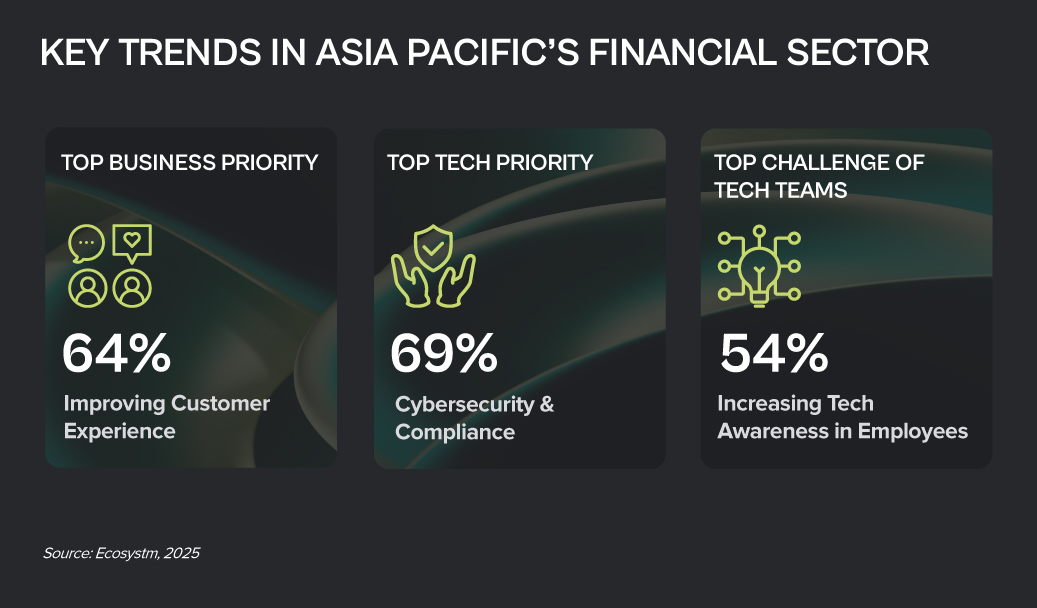
Click here to download “Future Forward: Reimagining Financial Services” as a PDF.
Scaling for Impact
CreditAccess Grameen, a leading microfinance institution in India, struggled to scale its operations to meet the rising demand for microloans. Its manual processes were inefficient, causing delays and hindering its ability to serve an expanding customer base.
To overcome this, CreditAccess Grameen digitised its operations, automating processes to handle over 80,000 loans per day, streamlining loan approvals and improving operational efficiency.
This transformation significantly reduced loan processing times, from seven to ten days down to a more efficient, timely process. It also enhanced customer satisfaction, empowered financial independence, and strengthened CreditAccess Grameen’s position as a leader in financial inclusion, driving economic growth in rural India.
Seamless Operations, Improved Reporting
After merging three separate funds, Aware Super, one of Australia’s largest superannuation funds, faced fragmented operations, inconsistent documentation, and poor visibility into workflows. These inefficiencies hampered the organisation’s ability to optimise operations, ensure compliance, and deliver a seamless member experience.
To overcome this, Aware Super implemented a business process management suite to standardise and automate key processes, providing a unified platform for continuous improvement.
The transformation streamlined operations across all funds, improving reporting accuracy, reducing waste, and boosting procurement efficiency. The creation of a Centre of Excellence fostered a culture of ongoing process improvement and regulatory compliance, elevating Aware Super’s process maturity and solidifying its leadership in the financial services sector.
Empowering Employees and Improving Operations
The Norinchukin Bank, a major financial institution serving Japan’s agriculture, forestry, and fisheries sectors, struggled with outdated, paper-based processes and disconnected systems. Manual approvals and repetitive data entry were hindering operations and frustrating staff.
The digital team implemented a low-code platform that quickly automated approvals, integrated siloed systems, and streamlined processes into a single, efficient workflow.
The results were striking: approval times dropped, development cycles halved, and implementation costs fell by 30% compared to legacy upgrades. Employees gained real-time visibility over requests, cutting errors and speeding decisions. Crucially, the shift sparked a wave of digital adoption, with teams across the bank now embracing automation to drive further efficiency.
Eliminating Handoffs, Elevating Experience
Axis Bank, one of India’s largest private sector banks, struggled with slow, manual corporate onboarding processes, which hindered efficiency and customer satisfaction. The bank sought to streamline this process to keep up with growing demand for faster, digital services.
The bank implemented a robust API management solution, automating document handling and onboarding tasks, enabling a fully digital and seamless corporate client experience.
This transformation reduced corporate onboarding time by over 50%, eliminated manual handoffs, and enabled real-time monitoring of API performance, resulting in faster service delivery. As a result, Axis Bank saw a significant increase in customer satisfaction, a surge in API traffic, and a deeper, more loyal corporate client base.
Taming Latency, Unleashing Bandwidth
WebSpace, renowned for its in-store payment systems, faced challenges as it expanded to wholesalers. The migration to a new architecture required low-latency cloud connectivity, but its legacy network, relying on hardware routers, caused performance slowdowns, complexity, and high costs.
WebSpace adopted a cloud-based routing solution, replacing physical routers with a virtual, automated system for multicloud connectivity, enabling on-demand configuration changes from a central control point.
With the new solution, WebSpace achieved faster cloud connectivity, reducing latency and increasing bandwidth. The modern, agile network reduced management costs and complexity, while usage-based billing ensured that WebSpace only paid for the resources it used, supporting its strategic expansion and enhancing overall efficiency.







